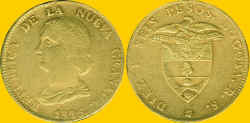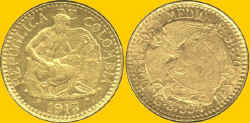This is the Worldwide Numismatics Website!
This is a modest collection of second millennium gold coins of Colombia from the early 19th to the early 20th Century
Click the thumbnail picture to see a larger version of the picture, then use your browser BACK button to return to the original page you were viewing.
SPANISH COLONIAL
2
Escudos - 17??
KM-017 -
6,77 g - 19 mm
This an example of "cob" coinage. The coin is from the reign of Philip V who ruled from 1700-1766. The date is off the planchet on this example which was minted from 1707 to 1746. The obverse has the royal arms (the lower third of the shield is unique to the Santa Fe mint) with HILIPV showing. The reverse features the cross of Jerusalem with part of the Latin legend RVM - RE showing.
1
Escudo - 1797-P
KM-056.2 -
3,38 g - 19 mm
The obverse features a bust of King Charles IV of Spain encircled by the Latin legend CAROL-IIII-D-G-HISP-ET-IND-R. (Charles IV, By Grace of God, King of Spain and the Indies) and the date 1797 at the bottom. The reverse has the royal arms encircled by the Latin legend FELIX-A-D-UTROQUE, with the mintmark P (for the Popayan mint) and the assayers' initials JF (Francisco Fernández de las Cajigas) at the bottom.
1
Escudo - 1813-P
KM-064.2 -
3,38 g
The obverse features a bust of King Ferdinand VII of Spain encircled by the Latin legend FERDND-VII-D-G-HISP-ET-IND-R. (Ferdinand VII, By Grace of God, King of Spain and the Indies) and the date 1813 at the bottom. The reverse has the royal arms encircled by the Latin legend FELIX-A-D-UTROQUE, with the mintmark P (for the Popayan mint) and the assayers' initials JF (Francisco Fernández de las Cajigas) at the bottom.
REPUBLIC OF NEW GRANADA
16
Pesos - 1839-P
KM-094.2 -
27,00 g
The obverse features a bust of Liberty encircled by the county's name in Spanish, REPUBLICA DE LA NUEVA GRANADA with the date 1839 at the bottom. The reverse has the arms of the Republic encircled by the denomination DIEZ I SEIS PESOS (16 Pesos), the mint name POPAYAN, and the assayer's initials R.U.
16
Pesos - 1845-B
KM-094.1 -
27,00 g
The obverse features a bust of Liberty encircled by the county's name in Spanish, REPUBLICA DE LA NUEVA GRANADA with the date 1845 at the bottom. The reverse has the arms of the Republic encircled by the denomination DIEZ I SEIS PESOS (16 Pesos), the mint name BOGOTA, and the assayer's initials R.S.
REPUBLIC
2½
Pesos - 1913
KM-194 - 3,99 g
Edge - Reeded
Mintage - 0,018M
The obverse features a stonecutter surrounded by the legend REPUBLICA DE COLOMBIA (Republic of Colombia) with the date 1913 at the bottom. The reverse has the Colombian arms with the denomination DOS PESOS Y MEDIO above the weight G(rams) 3,994 at the left, LEY (law) at the bottom, and (fineness) 0,916 2/3 to the right. This coin has a 45º rotated reverse.
5 Pesos - 1918/3
KM-195.1 - 7,99 g
Mintage
-
The obverse features a stonecutter surrounded by the legend REPUBLICA DE COLOMBIA (Republic of Colombia) with the date 1918/3 at the bottom. The reverse has the Colombian arms with the denomination CINCO PESOS above the weight G(rams) 7,988 at the left, LEY (law) at the bottom, and (fineness) 0,916 2/3 to the right.
2½
Pesos - 1919
KM-200 - 3,99 g - 19,2 mm
Edge - Reeded
Mintage
- 0.034M
The obverse features a large head bust of the Liberator Simon Bolivár (b1783-d1830) surrounded by the legend REPUBLICA DE COLOMBIA (Republic of Colombia) with the date 1919 at the bottom. The reverse has the Colombian arms with the denomination DOS Y MEDIO PESOS above the weight G(rams) 3,994) at the left, LEY (law) at the bottom, and (fineness) 0,916 2/3 to the right. The coin appears to be overstruck on another design. Bolivar took command of a Colombian force and captured Bogota in 1814. The Spanish drove him off. Bolivar marched into New Granada in 1819 defeating the Spaniards in Boyar in 1819, liberating the territory of Colombia. He then returned to Angostura and led the congress that organized the original republic of Gran Colombia (now Ecuador, Colombia, Panama, and Venezuela). Bolivar became its first president on December 17, 1819. Bolivar crushed the Spanish army at Carabobo in Venezuela on June 24, 1821. Next, he marched into Ecuador and added that territory to the new Colombian republic. After a meeting in 1822 with another great liberator, Bolivar became dictator of Peru. His army won a victory over the Spaniards at Ayacucho in 1824, which terminated Spanish power in South America.
10
Pesos - 1919
KM-202 - 15,98 g
Mintage
- 0,101M
The obverse features a large head bust of the Liberator Simon Bolivár (b1783-d1830) surrounded by the legend REPUBLICA DE COLOMBIA (Republic of Colombia) with the date 1919 at the bottom. The reverse has the Colombian arms with the denomination DIEZ PESOS above the weightG(rams) 15,976 at the left, LEY (law) at the bottom, and (fineness) 0,916 2/3 to the right. Bolivar took command of a Colombian force and captured Bogota in 1814. The Spanish drove him off. Bolivar marched into New Granada in 1819 defeating the Spaniards in Boyar in 1819, liberating the territory of Colombia. He then returned to Angostura and led the congress that organized the original republic of Gran Colombia (now Ecuador, Colombia, Panama, and Venezuela). Bolivar became its first president on December 17, 1819. Bolivar crushed the Spanish army at Carabobo in Venezuela on June 24, 1821. Next, he marched into Educador and added that territory to the new Colombian republic. After a meeting in 1822 with another great liberator, Bolivar became dictator of Peru. His army won a victory over the Spaniards at Ayacucho in 1824, which terminated Spanish power in South America.
5
Pesos -1920-A
KM-201.1 - 8,36 g
Mintage
- 0,870M
The obverse features a large head bust of the Liberator Simon Bolivár (b1783-d1830) surrounded by the legend REPUBLICA DE COLOMBIA (Republic of Colombia) with the date 1920 at the bottom. The reverse has the Colombian arms with the denomination CINCO PESOS above the weight G(rams) 7,988 at the left, LEY (law) at the bottom, and (fineness) 0,916 2/3 to the right. The mintmark A (for the Antioquia State mint in Medellin) is at the right bottom of the shield. Bolivar took command of a Colombian force and captured Bogota in 1814. The Spanish drove him off. Bolivar marched into New Granada in 1819 defeating the Spaniards in Boyar in 1819, liberating the territory of Colombia. He then returned to Angostura and led the congress that organized the original republic of Gran Colombia (now Ecuador, Colombia, Panama, and Venezuela). Bolivar became its first president on December 17, 1819. Bolivar crushed the Spanish army at Carabobo in Venezuela on June 24, 1821. Next, he marched into Educador and added that territory to the new Colombian republic. After a meeting in 1822 with another great liberator, Bolivar became dictator of Peru. His army won a victory over the Spaniards at Ayacucho in 1824, which terminated Spanish power in South America.
5
Pesos - 1928
KM-204 - 7,99 g
Mintage
- 0,314M
The obverse features a small head bust of the Liberator Simon Bolivár (b1783-d1830) surrounded by the legend REPUBLICA DE COLOMBIA (Republic of Colombia) with the date 1928 at the bottom. MEDELLIN, the minting city, is below the bust. The reverse has the Colombian arms with the denomination CINCO PESOS above the weight G(rams) 7,988 at the left, LEY (law) at the bottom, and (fineness) 0,916 2/3 to the right. Bolivar took command of a Colombian force and captured Bogota in 1814. The Spanish drove him off. Bolivar marched into New Granada in 1819 defeating the Spaniards in Boyar in 1819, liberating the territory of Colombia. He then returned to Angostura and led the congress that organized the original republic of Gran Colombia (now Ecuador, Colombia, Panama, and Venezuela). Bolivar became its first president on December 17, 1819. Bolivar crushed the Spanish army at Carabobo in Venezuela on June 24, 1821. Next, he marched into Educador and added that territory to the new Colombian republic. After a meeting in 1822 with another great liberator, Bolivar became dictator of Peru. His army won a victory over the Spaniards at Ayacucho in 1824, which terminated Spanish power in South America.
If you wish to return to the main page, click here - Main
If you want to return to the home page, please click here - Home

